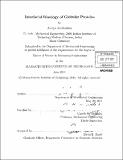Interfacial rheology of globular proteins
Author(s)
Jaishankar, Aditya
DownloadFull printable version (12.80Mb)
Other Contributors
Massachusetts Institute of Technology. Dept. of Mechanical Engineering.
Advisor
Gareth H. McKinley.
Terms of use
Metadata
Show full item recordAbstract
Protein-surfactant mixtures appear in many industrial and biological applications. Indeed, a fluid as vital as blood contains a mixture of serum albumin proteins with various other smaller surface-active components. Proteins and other surface active molecules are often adsorbed at an air-liquid or liquid-liquid interface due to favorable thermodynamics, and these interfaces play a role in such diverse fields as stabilizing foams and emulsions, controlling high speed coatings, the blood clotting process, designing synthetic replacements of biological fluids, etc. It is thus important to understand the interfacial behavior of protein-surfactant mixtures, especially the role it can play in bulk measurements of material properties. A complete description of the dynamics of these multi-component systems is still elusive. In this thesis, a comprehensive study of the rheology of a model globular protein solution is described. In conventional bulk rheological studies of globular protein solutions a yield-like behavior and shear thinning in the viscosity at low shear rates is observed, even for concentrations as low as 0.03% by weight. Typical explanations for this yield stress involve the introduction of long range colloidal forces that are stronger than electrostatic forces, and which stabilize a colloidal structure formed by the protein molecules. However, evidence for this structure from small angle X-ray scattering and small angle neutron scattering is lacking. In the first part of this thesis, it will be shown using interfacial steady and oscillatory shear experiments how the yield-like behavior observed in bulk rheology in fact arises out of a purely interfacial effect. We show that the yield-like behavior and shear-thinning observed in bulk rheology can be modeled by treating the interfacial layer of the adsorbed protein as a pure plastic material that yields at a critical strain. This model also accounts for the geometric dependence seen in bulk rheology experiments. The second part of this thesis investigates the rheological consequences of adding low molecular weight surfactants to globular protein solutions. Because non-ionic surfactants compete for the interface with the protein molecules, the resulting dynamics at the fluid interface can be complex. In addition to steady and oscillatory interfacial shear rheology, a new phenomenon called interfacial creep ringing-a term used to denote the periodic oscillations arising from the coupling between instrument inertia and interface elasticity-arises. It is demonstrated how these damped inertioelastic oscillations can be used to rapidly estimate interfacial viscoelastic moduli and also study the effect of the addition of non-ionic surfactants to globular protein solutions. We show that exploiting the interfacial creep ringing technique is useful as a way to rapidly determine the effects of interfacial viscoelasticity. It is also observed that increasing the concentration of the competing surfactant leads to progressively decreasing ringing frequencies and amplitudes, until visible ringing completely disappears beyond a certain concentration. Finally, we indicate future avenues of work including surface particle tracking to study these complex dynamics of protein surfactant mixtures.
Description
Thesis (S.M.)--Massachusetts Institute of Technology, Dept. of Mechanical Engineering, 2011. Cataloged from PDF version of thesis. Includes bibliographical references (p. 107-122).
Date issued
2011Department
Massachusetts Institute of Technology. Department of Mechanical EngineeringPublisher
Massachusetts Institute of Technology
Keywords
Mechanical Engineering.